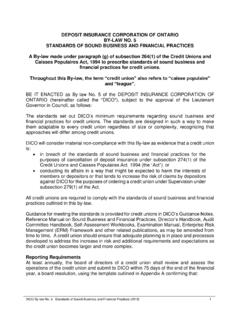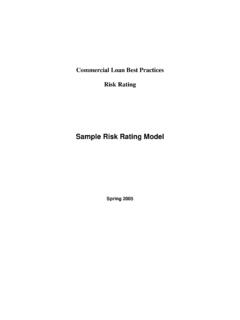Transcription of Liquidity Coverage Ratio Completion Guide - DICO …
1 Completion Guide : Liquidity Coverage Ratio July 2016 Ce document est galement disponible en fran ais. Deposit Insurance Corporation of Ontario | Liquidity Coverage Ratio Completion Guide 2 Table of Contents 1. INTRODUCTION .. 3 2. ASSUMPTIONS .. 3 3. HQLA .. 3 4. CASH OUTFLOWS .. 5 5. CASH INFLOWS .. 8 APPENDIX 1: SUMMARY HAIRCUTS AND CASH FLOW RATES .. 11 Deposit Insurance Corporation of Ontario | Liquidity Coverage Ratio Completion Guide 3 1.
2 INTRODUCTION 1. The LCR is a measure that aims to ensure that a credit union has an adequate stock of unencumbered high-quality liquid assets (HQLA) that can be converted into cash at little or no loss of value, to meet its Liquidity needs for a 30 calendar day Liquidity stress scenario. At a minimum, the stock of unencumbered HQLA should enable the institution to survive until day 30 of the stress scenario, by which time it is assumed that appropriate corrective actions can be taken by management and supervisors.
3 Also, given the uncertain timing of outflows and inflows, institutions are expected to be aware of any potential mismatches within the 30-day period and ensure that sufficient HQLA are available to meet any cash flow gaps throughout the period. 2. ASSUMPTIONS 2. These assumptions are based on a stressed Liquidity scenario that encompasses a combination of idiosyncratic and systemic stresses which measure the impacts of assumptions over a 30 day Liquidity horizon. Stress assumptions include: cash flows from eligible unencumbered liquid assets; partial run-off of retail deposits; partial loss of unsecured wholesale funding and secured financing capacity; and unscheduled draws on committed but unused credit facilities.
4 3. This stress test should be viewed as a minimum requirement. Credit unions are expected to conduct their own stress tests to assess the level of Liquidity they should hold beyond this minimum, and construct their own scenarios that could cause difficulties for their specific business activities. Such internal stress tests should incorporate longer time horizons than 30 days. 4. The LCR has two components: (a) Value of the stock of HQLA in stressed conditions; and (b) Total net cash outflows, calculated according to the scenario parameters outlined below.
5 Net cash outflows is defined as the total expected cash outflows minus total expected cash inflows in the specified stress scenario for the subsequent 30 calendar days. 5. The value of the Ratio should be no lower than 100% ( the stock of HQLA should at least equal total net cash outflows) on an ongoing basis as the stock of unencumbered HQLA is intended to serve as a defense against the potential onset of Liquidity stress. 3. HQLA 6. All assets in the stock of HQLA should be unencumbered. Unencumbered means free of legal, regulatory, contractual or other restrictions on the ability of the credit union to liquidate, sell, transfer, or assign the asset.
6 An asset in the stock should not be pledged (either explicitly or implicitly) to secure, collateralise or credit-enhance any transaction, nor be designated to cover operational costs (such as rents and salaries). Assets received in reverse repo and securities financing transactions that are held at the institution, have not been rehypothecated, and are legally and contractually available for the institution's use can be considered as part of the stock of HQLA. Deposit Insurance Corporation of Ontario | Liquidity Coverage Ratio Completion Guide 4 7.
7 There are two categories of assets that can be included in the stock of HQLA. Assets to be included in each category are those that the credit union is holding on the first day of the stress period, irrespective of their residual maturity. Level 1 Assets 8. Level 1 assets can be included without limit and include: Cash on hand currently held by the credit union; Statutory Liquidity Reserves with Central 1 or a League; Securities issued under the NHA MBS (including holdings of NHA MBS, and CMBs and unencumbered qualifying replacement assets where (a) there is sufficient guarantee allocation room to allow for the re-designation of replacement NHA MBS as NHA MBS for sale to the market OR the guarantee fee has been paid at issuance, AND (b) the credit union has the ability to monetise the NHA MBS in a timely manner.)
8 And Qualifying marketable securities representing claims on or guaranteed by sovereigns, central banks, PSEs or multilateral development banks assigned a 0% risk-weight under the Basel II including any debt instrument that can be readily converted into cash through repo or cash markets. Level 2 Assets 9. Level 2 assets are limited to a 40% cap of total HQLA after applicable haircuts. Level 2A Assets 10. A 15% haircut is applied to the current market value of each Level 2A asset which includes: Qualifying marketable securities representing claims on or guaranteed by sovereigns, central banks, PSEs or multilateral development banks assigned a 20% risk-weight under the Basel II; and Qualifying corporate debt securities (including commercial paper) and covered bonds that have a long-term credit rating from a recognised external credit assessment institution (ECAI) of at least AA.
9 Level 2B Assets 11. Level 2B assets are also limited to a 15% cap of total HQLA after applicable haircuts. 12. Level 2 B assets include: 25% haircut - Residential mortgage backed securities (RMBS); 50% haircut - Qualifying corporate debt securities (including commercial paper) and covered bonds that have a long-term credit rating from a recognised external credit assessment institution (ECAI) between A+ and BBB-;and 50% haircut - Qualifying corporate (non-financial) common equity shares. Deposit Insurance Corporation of Ontario | Liquidity Coverage Ratio Completion Guide 5 4.
10 CASH OUTFLOWS 13. Total expected cash outflows are calculated by multiplying the outstanding balances of various categories or types of liabilities and off-balance sheet commitments by the rates at which they are expected to run off or be drawn down. Where amounts cannot be readily determined for any specific category, credit unions must report amounts using the more conservative (higher run offs) category under each funding source. Credit unions may report monthly amounts by applying percentage factors based on the most up to date financial year end balances for each category as applicable.



